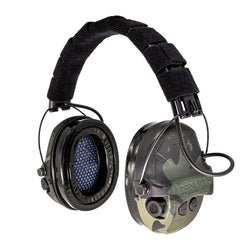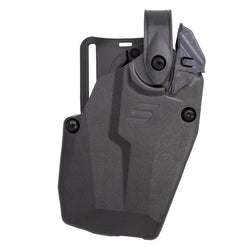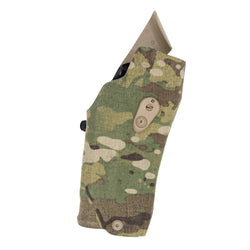Have you been wondering what the “cant” of a holster is? Holster “cant” is the angle at which the firearm sits in the holster relative to your body. This means an adjustable cant allows you to rotate the holster forward or backwards to change the angle at which you draw from the holster.
That’s the short and simple answer. But before we talk more about that, let’s talk about holsters in general for just a moment. Holsters are more than just a place to store your firearm or carry them on your person. They are essential safety tools as well.
A quality holster provides retention, safety, and accessibility all at the same time. The point is to keep you and those around you secure while allowing you to quickly access the gun when needed. Not all holsters provide these three features.

Unfortunately, many people choose cheap, ill-fitting holsters that don’t properly retain their firearms or allow for a smooth draw. Poorly made holsters can fail under stress, drop the weapon unexpectedly, or even make drawing unnecessarily dangerous.
I’ve used a lot of different holsters over the years, and there are some great holster companies out there. For leather holsters, I love Bianchi and Galco.
But today we are going to talk more about duty holsters that have an adjustable cant.
For this type of holster, I like to use Safariland because of their quality, retention settings, and multi-configuration ability.
Safariland: The proof is in the pudding
I was introduced to Safariland holsters in the police academy. Before that, I thought nylon was a great cheap option. Needless to say, I was a little naive about holsters and gun gear in general.
I didn’t take long in my law enforcement career to learn the importance of having a quality holster. For those who plan to carry a gun in the open, a holster that has multiple locking mechanisms is a must.
But you also need to be able to draw the gun quickly too. Safariland holsters were made just for this purpose which is why members of the military, law enforcement, and citizens all use them.

Over the years, Safariland has made some awesome improvements and features to their holsters. The Quick Locking System is one of my favorites because it allows me to switch holsters around from one belt to another.
The other great thing about their duty holsters is the ability to adjust the cant of the holster.
What Does “Cant” Mean with a Holster?
As I mentioned above, the holster “cant” refers to the angle at which the firearm sits in the holster relative to your body.
Typically measured in degrees, cant determines how your firearm is oriented for drawing.
A neutral cant (0 degrees) keeps the gun straight up and down, while forward cant tilts the grip forward toward your belt buckle. As you would expect, a reverse cant tilts the grip backward.

Safariland makes holster cant adjustments easy for each person to customize to their preference.
I mentioned above that I love using leather holsters from time to time. Some leather holsters are not adjustable, and others use a system of multiple belt loops. If you have ever wondered why there are two or more slots for your belt on a leather pancake holster, that’s why. When you move your belt from one loop to the other, it changes the angle (cant) of the holster from your body.
With duty style holsters, this is done by some type of rotating system on the back of the holster. We will talk more about adjusting Safariland holsters in a moment.
What Is the Purpose of an Adjustable Cant on a Holster?
So now that we have talked about what holster “cant” is, let’s talk about why it’s an important feature on a holster.
The most popular term you will hear regarding holster cant is the “forward cant,” also known as the FBI cant. An FBI cant refers to a holster that is canted towards the belt buckle 10-15 degrees.
The benefits of this angle is to accommodate natural body movements and ergonomics. When the firearm’s grip tilts forward, it often aligns better with your hand during the draw. This reduces the time and effort needed to get on target.

Forward cant also enhances concealment, for both inside-the-waistband (IWB) and outside-the-waistband (OWB) holsters worn at the hip.
A tilted grip reduces printing (the visible outline of the firearm) by tucking the grip closer to your body. For individuals who carry concealed daily, this subtle change can make a significant difference in maintaining discretion.
While a forward cant is the most popular angle used on holsters, many use a neutral or even reverse cant.
A neutral or reverse cant may work better for appendix carry because the firearm is positioned at the front of the waistband.
It’s not just about ergonomics
Adjustable cant isn’t just about comfort or concealment. It can also improve safety for those who carry OWB.
A poorly angled holster can make it harder to draw without flagging yourself (pointing the muzzle at your body). By adjusting the cant, you can create a more natural and safer draw angle.
On duty holsters, a forward cant will also make it harder for someone to remove the gun from the holster. Most of the time, this is done from behind the person carrying the gun.
When the grip of the gun is tilted forward, the gun must draw towards the belt buckle to clear the holster. This makes the task harder for someone standing behind the person wearing the gun.

How to Determine the Best Cant for You
Finding the right holster cant takes a bit of experimentation. Start by considering your primary carry position. If you carry at the hip, a slight forward cant, typically 10 to 15 degrees is a good starting point. This angle often balances concealment and accessibility.
For appendix carry, a neutral cant is usually the most effective, keeping the firearm’s grip upright for a fast and smooth draw. Behind-the-hip carriers may need a more pronounced forward cant, often around 20 degrees, to improve comfort and access.

When adjusting your holster, test the draw in various positions to ensure the angle feels natural and efficient. Pay attention to how your hand aligns with the grip and how the firearm clears the holster.
Your goal is to minimize unnecessary movement and ensure a consistent, fluid draw.
Adjusting the cant on a Safariland holster
Many of Safariland’s duty holsters use a three-hole attachment system. This attaches the holster to any number of devices designed to carry your holster. This could be a belt attachment, drop-leg attachment, etc.
On the back of the holster, loosen the three screws just enough to allow the holster to swivel. It will not feel like the holster has much room to rotate, but a little rotation (cant) goes a long way. In the photo below, you can see how this is done.
Once the holster is in the position you desire, retighten the screws before wearing the holster.

I recommend trying out a few different angles and drawing the handgun to see which one works best for you.
If you are looking at leather holsters, pay attention to the cant of the holster as some are not adjustable. I used a Bianchi open top holster for years. It had a forward cant that was not adjustable.
I liked the angle so it worked out great for me, but make sure a fixed cant holster will work for you before purchasing it.
Find what works for you
While it’s often overlooked, finding the right holster cant makes a big difference in your draw. I use a forward cant on many of my holsters but prefer a neutral cant on others.
It all depends on the holster, where you carry the holster and what is comfortable for you.









